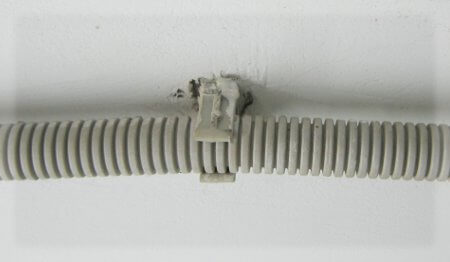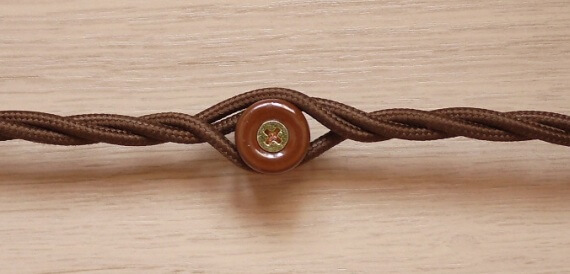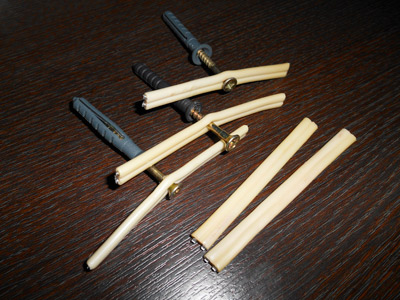8 ways to mount the cable to the wall
Outdoor wiring
To conduct open wiring, it is necessary to fix the cable over the decorative wall decoration. As a rule, this option of wiring is used in wooden houses and garden buildings, for example, in a garage or hozblok. Cable ducts, clips or special porcelain insulators can be used to attach wires to walls. Consider the features of each of the options.
Cable channels
Today, the fastening of wires and cables in special plastic channels is most often used. This is due to the fact that cable channels They have an attractive appearance, low cost and most importantly - allow you to quickly fix a group of conductors in one place. To independently mount using this method, it is enough to fix the plastic box on the wall using self-tapping screws.
If you need to connect several elements in one line, you can use special connections provided by the manufacturer. After the cable channel is fixed, you can insert all the cables into it and close the front cover (it is latched). More about how to fix the cable duct to the wall, we told in a separate article.
Clips
Fastening wires and cables with clips is used only for installation of wiring in pipes, and also if the conductor is additionally protected by a corrugated pipe. In this case, attaching the wiring to the wall and ceiling is very simple.
If the surface is wooden, all that is needed is to fix the clip using wood screws. In a concrete wall or ceiling, you must first drill holes with a perforator, then drive in the dowels, after which the clips themselves must already be fixed. All installation technology is graphically provided in the video example:
By the way, clips can be mounted not only indoors, but also on the street. This method is suitable if you decide to conduct street wiring along the cinder block or brick walls of structures.
If you want to fix the cable
Insulators
Fastening the wires to the wall on the insulator is most often used when installation of electrical wiring in a wooden house and a bathhouse. First you need to fix the porcelain barrels themselves, which are fixed to the wooden paneling or the log house using self-tapping screws, then twist the cores into a tight tourniquet and pass it through the insulator as shown in the photo below:
In order not to twist the wires on your own, you can buy a special antique wiring, which is already twisted. About, how to do retro do-it-yourself wiringread in the corresponding article.
Nail staples
This mounting method is suitable for television and telephone cables, as well as lines from the Internet.There are flat and round plastic staples that can easily be attached to the wall using the small studs included.  A very convenient installation option, which is used in order to quietly pass the cable over the baseboard in the house or apartment.
A very convenient installation option, which is used in order to quietly pass the cable over the baseboard in the house or apartment.
Concealed wiring
When installing wiring in a hidden way (in a shtrobe under the plaster), there are more options for attaching wires and cables to the walls. Consider from the simplest and most effective to the least convenient.
Dowel clamps
Dowel clamps, in fact, like dowel ties, are very convenient to use. These fasteners have a low cost and also allow you to quickly make wiring. Ties, of course, are more practical and versatile, therefore, we recommend choosing them for attaching wires in a strob. All you need is to drill a hole in a concrete, brick or wooden surface, insert a special wall plug into it, and then drive in a special expansion peg.
Fixing the wall plug in the wall is even easier. You just need to drill a hole, and then drive a cable clamp into it, as shown in the picture below. To attach the wire to drywall, we recommend using a special butterfly plug, into which fasteners are already screwed (second picture).

By the way, if you have already carried out electrical wiring on the walls and you need to attach another cable to it, you can use ordinary plastic clamps. For mounting in this way on the street, it is recommended to use black clamps that are resistant to ultraviolet radiation!
Quick drying solution
In order to quickly fasten wires and cables in the strobe, you can use a quick-drying solution: alabaster or gypsum. In this case, you need to act in a hurry, because the ready-made solution solidifies very quickly, and you may not have time to fix the entire selected area in the wall. As a rule, you need to “freeze” the cable in the prepared strobe every 40 cm, as shown in the photo.
The advantage of this method of fastening the wire is that you do not need to spend much on the material and you can also do without nails and without drilling the walls. The main disadvantage is the quick solidification of the solution, so you need to breed gypsum or alabaster in small volumes. In addition, attaching more than two conductors to the wall will be very difficult.
Homemade Staples
Fastening the cable to the wall with the help of brackets will provide a reliable grip on the conductor, as well as allow you to fix several groups of cables in one route. In order to attach the conductors with brackets, you first need to make these fasteners with your own hands. In this case, you will need either thin galvanized steel, cut into strips, or aluminum wire PTPZH. The length of each staple should be from 6 to 7 cm. You need to cut the material with suitable pieces, and then drill a suitable hole in the center of each. Then everything is simple - the wall is drilled in suitable places, after which the dowel is driven in and “quick installation” is carried out. You can also hammer staples with nails if fastening is done on wooden walls.

The disadvantages of this method are the long preparation time for homemade staples, the likelihood of damage to the insulation of the conductor (if strips of galvanized steel are used), as well as the possible appearance of red spots on the wallpaper if the steel starts to oxidize. We do not recommend using this option if you need to fix the wire in the wall under the plaster, because There are more modern and convenient installation methods. It is reasonable to use staples in order to attach a heating cable to the system warm floor.
Assembly site
Well, the last one, one of the modern options that will allow you to fix the wire on a tile or furniture (for example, a table) - the use of mounting sites with one self-adhesive side (Velcro). Everything is very simple here, so there’s no sense in explaining the nature of the fastening. You can see the installation sites in the photo:
That's all the ways to fix wires and cables to the wall. As you can see, there is a wide range of fasteners that will allow you to choose the most suitable option for various application conditions.
Also read:







